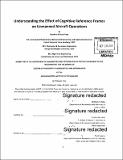Understanding the effect of cognitive reference frames on unmanned aircraft operations
Author(s)
Rabe, Matthew Richard
DownloadFull printable version (73.11Mb)
Other Contributors
Massachusetts Institute of Technology. Department of Aeronautics and Astronautics.
Advisor
R. John Hansman.
Terms of use
Metadata
Show full item recordAbstract
As an ever-greater share of our national military airborne resources transition from manned to unmanned aircraft (UA) the issues associated with unmanned aircraft operations become more and more important. This study seeks to understand the difficulties associated with controlling both the unmanned aircraft and an onboard video sensor. Traditional unmanned aircraft involve multiple operators controlling multiple control displays that are often oriented on misaligned reference frames. One example unmanned aircraft mission includes a target described on a north-up reference frame, such as a map. The pilot plans a flight path, to this target, on a north-up map, but controls the aircraft along that flight path using an aircraft-view reference frame that offers a forward-looking cockpit view. Finally, the sensor operator controls the sensor to point at the target area using a sensor-view reference frame that offers a sensor viewfinder perspective. Any unmanned aircraft operator or team of operators is required to manage tasks across these multiple reference frames (north-up, aircraft-view, and sensor-view). This study investigated several display design techniques that had the potential to reduce the cognitive burden associated with correlating information from multiple reference frames. Orientation aids, reference frame alignment, display integration, and reduced display redundancy were all evaluated with human subject simulator experiments. During four separate experiments, a total of 80 subjects were asked to complete a series of representative unmanned aircraft operational tasks involving target acquisition, imagery orientation, target tracking, and flight path control. A simulator was developed to support this effort and allow for modification of display characteristics. Over all four experiments the reference frame alignment technique reduced basic orientation time and improved target acquisition time along with other performance and workload measures. The currently accepted practice of placing an orientation aid, such as a north arrow, on the displayed sensor video was only significant on the basic imagery orientation task and did not have a significant impact on the more involved target acquisition task. This research introduced a potential benefit of reference frame alignment on unmanned aircraft operations.
Description
Thesis: Ph. D., Massachusetts Institute of Technology, Department of Aeronautics and Astronautics, 2016. Cataloged from PDF version of thesis. Includes bibliographical references (pages 191-200).
Date issued
2016Department
Massachusetts Institute of Technology. Department of Aeronautics and AstronauticsPublisher
Massachusetts Institute of Technology
Keywords
Aeronautics and Astronautics.